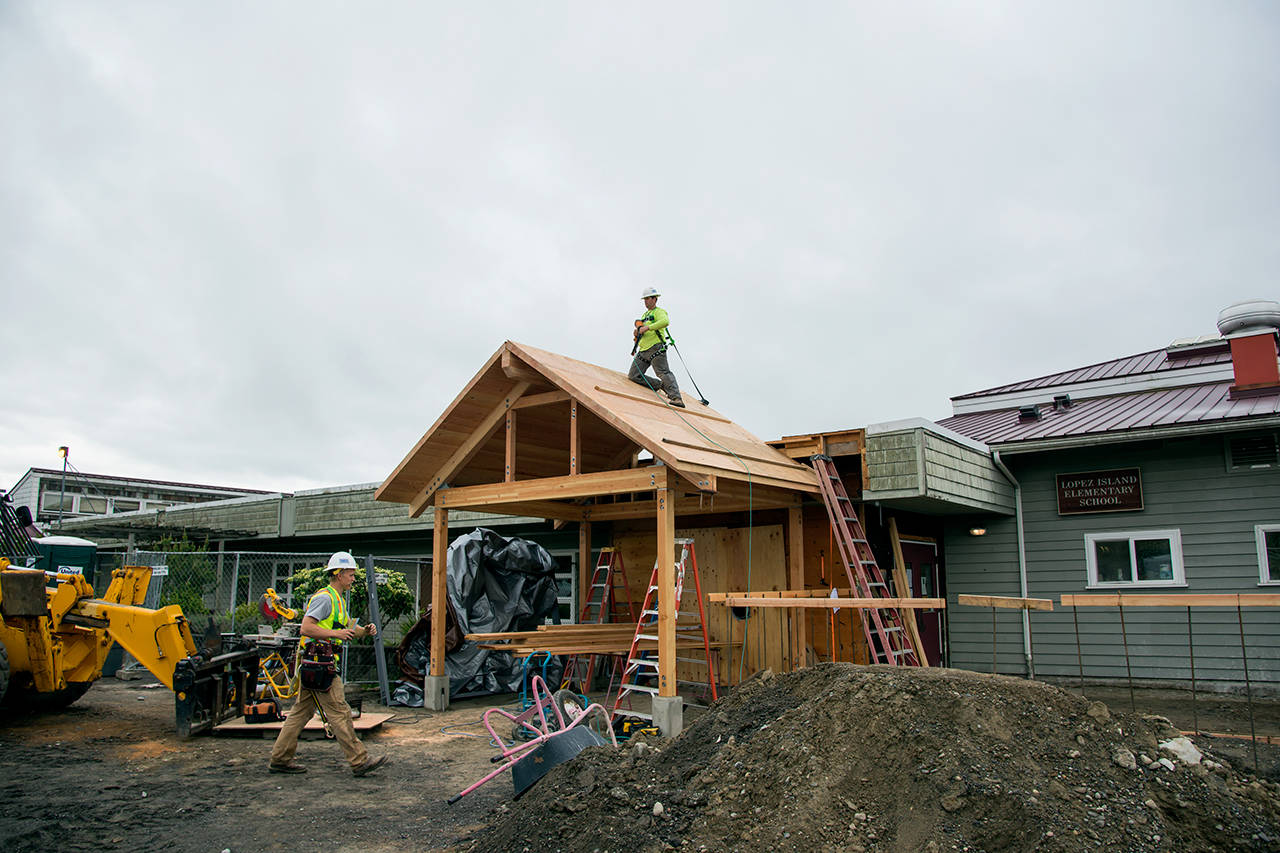Submitted by Lopez Island School District
The Lopez Island School 15-month renovation project is in its final stretch. Completion is scheduled for the middle of August. The project remains on schedule and budget. What follows are answers to commonly asked questions about the project.
What has been accomplished?
All high school, middle school, elementary classrooms and hallways have been renovated and technology upgraded. All restrooms and plumbing have been renovated or replaced. The elementary office, work room, and health room have been reconfigured and upgraded. New heating and air handling systems have been added in the gym. Upgrades at Decatur school are complete.
The new food production classroom and the renovated teaching shop have been completed. Most of the school’s electrical, the internet, and fire alarm infrastructure has been renovated and upgraded. Fire sprinklers have been added to the shop/science wing of classrooms, locker rooms, and adjoining hallways.
What work remains to be done?
Major work over the 2017 summer includes: Adding a new entrance and service yard at the elementary building. Replacing the flat roof on the elementary building. Renovating the school kitchen, the multipurpose room/cafeteria, and the science and art classrooms. Completing the septic system replacement. Replacing the gym lighting with a high efficiency/high lumens LED lighting system. Cleaning, repairing, and repainting of the school’s exterior.
What have been some of the key challenges faced?
The fundamental challenge has been to renovate a school building while using it at the same time to hold school. Lopez only has one school complex and there were no options for moving students off-site. This made for a unique and demanding situation and the District was dependent on and extremely grateful for the extra effort of the staff, students, and parents throughout the school year.
A critical part of that challenge has been maintaining separation between our construction work zones and adjoining classroom and office spaces. At one point during the year construction air unexpectedly entered into occupied spaces and this was unacceptable. With the help of the construction team, staff, and parents a new approach was adopted to more fully separate the construction areas from occupied space and to put in place more robust monitoring of our interior air quality. Those changes have been successful in preventing any additional such events.
A second major challenge has been upgrading and replacing our aging septic system. The first set of new septic holding tanks installed last summer, while operational were ultimately deemed to be unacceptable for the longer run (30-plus years). As such, those tanks are currently being replaced with different tanks that do fully meet the performance requirements specified by the school district. Moreover and importantly, none of the costs associated with substituting the tanks will be borne by the school district or by taxpayers, nor will this work negatively impact the renovation budget or project schedule.
Finally, as with any renovation project, a number of unforeseen conditions arose. In particular underground pipes and electrical conduits were in places that did not match with existing building plans and were not discoverable in advance by pipe scoping investigations or other analyses. Fortunately, sufficient contingency funds had been budgeted to cover the cost of these ‘expected’ unexpected conditions. Moreover, the school now has a much improved digital archive of as-built conditions that will make the buildings easier to maintain and upgrade in the future.
Budget and schedule?
Again the project is on budget and schedule. Substantial completion is on track for mid-August. With the help of our budgeted contingency funds and some adjustments for optional items, the capital budget will cover the full cost of the renovation as originally planned.
Those capital funds primarily came from the $9.6 million bond approved by voters in 2014 and supplemented by state grants awarded the school. The bond was originally planned for a 20-year payoff, but given a lower and more favorable than anticipated interest rate when sold, the bonds now pay off in 15 years with no increase in the annual payment for taxpayers. As such these bonds will be fully retired five years early in 2030.
The one caveat to the completion date is an outstanding state capital grant application yet to be awarded. This grant could allow us to perform additional work beyond our planned program (e.g., new bus loading zone, additional high-efficiency lighting, upgraded school water supply, and additional safety and security upgrades). If we are awarded the grant the additional work may push our end date into the fall and/or those additional projects may be performed during the summer of 2018.



